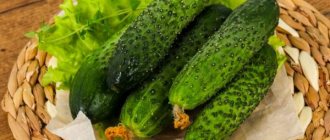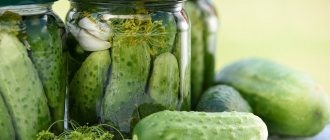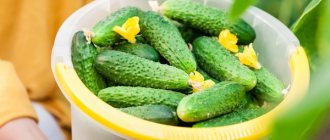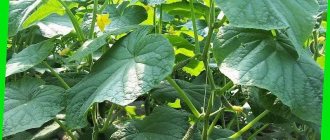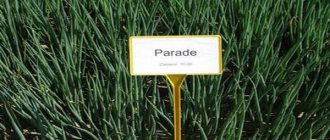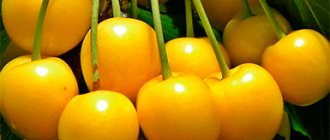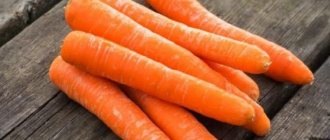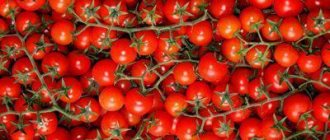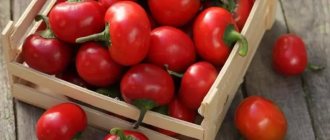Description of cucumbers Sheer perfection
Cucumber Same perfection is a hybrid variety that was developed by Russian breeders for cultivation in open and closed ground (in a greenhouse or hotbed).
In terms of ripening time, the plant belongs to the ultra-early varieties, since the first fruits appear 40 days after the formation of the first shoots.
The variety Self Perfection f1 is distinguished by long-term fruiting and the amount of mineral components it contains: fiber, magnesium, vitamin A, B, zinc, potassium and iron. In addition, cucumber Sheer perfection painlessly cleanses the intestinal tract and improves its motility. Cucumbers are also distinguished by their versatility in use: they are used for preparing salads, preparations, for pickling and canning.
Variety characteristics:
- The bushes of the plant are low (reach 1.5 m);
- The root system of the plant spreads along the surface of the earth;
- Description of the flowering variety: female flowering predominates;
- Cucumbers are cylindrical in shape and grow up to 10 cm;
- The peel of the fruit is thin, light green in color, with small white tubercles and fluff on the surface;
- Description of cucumber pulp: juicy, soft, crispy, without voids and seeds;
- Taste characteristics of the variety Sheer perfection: sweet, not bitter.
Productivity
It is recommended to harvest the crop daily. After collecting the first offspring, nitrogen fertilizers are applied. You can also water the cucumbers with an infusion of organic matter, such as nettle, manure or droppings.
The fruits of the hybrid Perfection itself f1 can be used in different ways: fresh, in salads, soups and canned food.
The fruits of the hybrid “Itself Perfection” have all the necessary qualities for successful preservation:
- Compact size;
- Thin skin;
- Dense and crispy flesh;
- Taste without bitterness.
Most often, such gherkins are grown specifically for winter harvesting. However, even in fresh form, this hybrid will delight you with its excellent taste.
Among other gherkin-type varieties that are ideal for preservation, the following should be highlighted:
- “Masha” is an early-ripening hybrid with elastic fruits that retain commercial qualities for a long time;
- “Bouquet F1” is an early ripening cucumber with small but tasty fruits;
- “Murashka” is a variety with sweet and aromatic pulp that opens best when preserved;
- "Bjorn F1" is a Dutch hybrid with excellent commercial qualities.
With proper care, up to 10 kg of cucumbers can be harvested from 1 plant, which in terms of square footage is 20 kg/sq.m.
This hybrid is best grown in the middle zone in greenhouses. The optimal regions are: Bryansk, Moscow, Belgorod, Voronezh regions. There is known experience of successful cultivation of plants in the south (Crimea and Astrakhan) in open ground.
Pros and cons of the variety
Cucumber Sheer perfection f1 is not in vain popular among experienced vegetable growers. The variety is characterized by a list of positive characteristics, thanks to which it is preferred. Let's look at the description of the positive traits Perfection itself.
pros
- High level of productivity (up to 30 kg of gherkins are harvested from 1 m2);
- Early ripening of fruits;
- Cucumbers ripen evenly and have the same shape and size;
- Duration of fruiting of the variety Perfection itself;
- Resistance to air temperature;
- Cucumbers Perfection itself are resistant to many crop diseases;
- Unlike the Monolith variety, Self Perfection f1 cucumbers are resistant to shading of the land.
Minuses
Experience in growing the variety Perfection itself also allows us to highlight a number of negative characteristics:
- The need for regular watering;
- Lack of seeds for next planting.
Advantages and disadvantages
The cucumber called “Perfection Itself” has a sufficient number of advantages over other new hybrid forms:
- greens are intended for universal use;
- cucumbers have excellent taste;
- fruiting is abundant and long;
- resistance to most common diseases;
- Possibility of growing in open or protected ground.
Among the advantages of this hybrid are:
- Self-pollinating;
- Friendly and prolonged ripening of fruits;
- Strong immunity;
- High yield;
- Excellent taste.
Oddly enough, “Perfection Itself” still has some shortcomings. However, they are inherent in most hybrids:
- High cost of seeds;
- Inability to grow in the second generation;
- Significant dependence of yield on soil nutrition.
Landing Features
Since Samo Perfection f1 cucumbers are planted both in open and closed soil, they are planted in two ways: sowing and seedlings. Let's consider the description of two methods.
Landing dates
In open soil, seed material Perfection itself is sown on the 15th of May, when the earth has warmed up to at least 15 degrees Celsius.
For the seedling method, seeds of Perfection F1 are recommended to be planted at the end of March - the first half of April.
Site preparation
Planting cucumbers for perfection is recommended in a sunny area, protected from drafts. However, the variety is distinguished by its resistance to shade, so it can be planted in a non-sunny place.
It is necessary to prepare the site in the autumn, when the beds are cleared of cucumber predecessors. To do this, the ground is carefully dug up and fed with manure or bird droppings.
Before planting, it is necessary to loosen the soil, remove all weeds and feed the soil with minerals containing ammonium nitrate.
Planting seeds
Before sowing the seeds, their perfection itself must be germinated. This process will accelerate the development and growth of future bushes of the variety. To do this, the seed is placed in a damp cloth and placed in a cold room for 24 hours. Next, the seeds must be processed so that they do not become infected with any infection. To do this, use a manganese solution: the seeds are dipped in the solution for 30 minutes.
Afterwards, the future cucumbers are placed in holes, the depth of which should not exceed 2 cm. As a rule, 2 seeds are placed in one hole. This is done in case one of the seeds still does not germinate. After sowing the seeds of the Perfection Self variety, the ground must be covered with a thick film so that the seeds do not freeze.
Planting seedlings
To get good seedlings, the seeds are planted in peat containers, which in the future will prevent harm to the roots of the plant. Seeds are placed in holes to a depth of 2 cm. As a rule, 2 seeds are placed in each hole.
When growing seedlings of the variety, the air temperature should be observed: 25 degrees Celsius.
After the seedlings have formed, the room temperature should be lowered by several degrees. Plant cucumbers in open ground Perfection f1 itself is necessary only after the formation of 4 leaves on future bushes. Afterwards, the cucumbers are thoroughly watered with water at room temperature.
Planting scheme
Cucumbers Self Perfection f1 are recommended to be planted according to the pattern of 15 cm between bushes and 60 cm between beds. Thus, only 2 bushes are planted per 1 m2. This planting scheme allows you to create favorable conditions for the growth of bushes of the variety. If the bushes are planted close to each other, barren flowers begin to form.
How to grow cucumbers in a greenhouse (video)
The hybrid is suitable for growing both in a greenhouse and in open ground. It can be sown in the soil on the site by seeds or using seedlings.
Let's consider two methods of planting crops, find out their features and advantages.
When growing this hybrid form, it is very important to remember that in cold and cloudy weather, plant growth slows down, and the root system stops actively absorbing any added nutritional components. For this reason, it is not recommended to feed cucumber bushes in such weather. But regular and frequent harvesting, judging by the reviews of most vegetable growers, promotes abundant and prolonged fruit formation, and also greatly slows down the aging process of the plant and is guaranteed to increase the overall yield.
Care
The yield of the variety The perfection itself directly depends on the work on caring for the bushes. Experts recommend performing the following procedures: watering and hilling the plant, tying it up and forming bushes. Let's consider the description of these works.
Watering
Since the hybrid variety has a shallow root system, it requires systematic watering.
Watering work is carried out at least 2 times every 7 days. Watering cucumbers in perfection is recommended with water at room temperature in the early morning or evening. To do this, the liquid is infused in the sun, in a greenhouse or greenhouse, or heated independently.
It is worth paying attention that the soil should not dry out, and after watering it is recommended to loosen the soil.
Garter and bush formation
The main factor in growing cucumbers of the variety Self Perfection f1 is the formation of bushes, since the development of fruits and their volume depend on this procedure.
As a rule, cucumbers are grown with 1 stem. To do this, the lower nodes are blinded, and the stem itself is attached to a pre-installed trellis. If the cucumbers are not provided with support for their growth, the ovaries will begin to turn yellow and dry out.
Top dressing
Cucumbers Sheer perfection requires 4-5 feedings throughout the entire growing season. The variety is fed with minerals that contain phosphorus, nitrogen and potassium. Manure or bird droppings are also used.
Cucumbers are fed with perfection itself, as a rule, at the root in the evening.
Hilling
Cucumbers are a crop that does not require hilling, since the root system of the plant is located close to the surface of the earth and spreads along it. Therefore, during hilling, the roots of the plant can be damaged, as a result of which the plant begins to wither and rot.
However, vegetable growers strongly recommend loosening the soil with a pitchfork. This process allows you to remove the stagnant layer of soil, supply the necessary amount of oxygen to the roots of the plant, and also get rid of weeds.
Diseases and parasites
The breeders of the variety Same Perfection f1 took care of the plant’s strong immunity. Cucumbers are resistant to many crop diseases. However, experience in growing the variety shows that cucumbers are still susceptible to downy mildew, as well as the invasion of pests such as melon aphids and whiteflies. Let's consider the description of infections and pests.
Downy mildew
Downy mildew (also called peronosporosis) is an infection that causes damage to cucumbers due to high atmospheric pressure, high humidity, and also as a result of dense planting of bushes.
With peronosporosis, the formation of small yellow spots on the surface of the leaves is observed, which soon acquire an oily consistency. Also, a gray-violet coating appears on the leaves. Over time, the spots begin to enlarge and darken, acquiring a brown or brown color, and soon the leaves completely wither and die.
To prevent downy mildew, experts recommend chemicals such as Previkur, Oksikhom, Abiga-Pik and Ordan.
melon aphid
The melon aphid is a small insect that damages the leaves of the plant, as a result of which they become yellow in color, begin to wither, curl and fall off. In addition, flowers and ovaries of bushes fall and die. As a rule, melon aphids are located on the leaves, stems, shoots and buds of the plant. To combat melon aphids, it is recommended to use the chemical preparations Metaphos, Decis-Lux and Inta-Vir.
Whitefly
Whitefly is a small pest that usually affects garden crops. As a rule, the insect is located on cucumbers grown in greenhouse conditions.
With whiteflies, the formation of white spots on the leaves, similar to plaque, is observed, as well as their yellowing or blackening if the insect is present for a long time. On the back of the leaves, small yellow-white scales form - whitefly larvae.
To combat whiteflies, the chemical preparations Aktara, Akarin and Admiral, as well as the biological substance Vericillin, are used. In addition, experts recommend folk remedies: solutions of soap, garlic or dandelion.
Harvesting and storage
Picking cucumbers The very perfection f1 is necessary every day, since ripened fruits interfere with the formation and development of new cucumbers.
It is recommended to store the harvest in the basement or cellar, since the temperature of such rooms usually does not exceed 4 degrees Celsius.
The fruits of the variety are placed in wooden boxes, since it is precisely such containers that allow the necessary amount of oxygen to pass through to the cucumbers and does not allow them to rot. If one of the fruits begins to rot, it is necessary to remove not only it, but also all cucumbers in contact with it. If the Same Perfection fruits are intended for fresh use, they are placed in the refrigerator.
